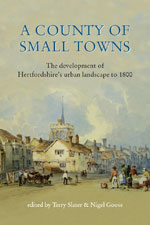From pre-sale publicity
In a combination of essays on key towns and chapters with more wide-ranging themes, this collection brings together research into the origins, growth and topography of Hertfordshire’s towns. Unusual in having no single dominant city, Hertfordshire provides rich evidence of the diverse ways in which towns come into existence and then develop. In Roman times it boasted three major urban centres - the municipium of Verulamium, and the ‘small towns’ of Baldock and Braughing - whilst the county town, Hertford, does not seem to have assumed importance before two burhs were founded, one on each side of the river Lea, in 912 and 913, as part of the general administrative reorganisation following the reconquest of eastern England from the Danes.
Domesday Book records, at most, six towns in Hertfordshire - St Albans, Ashwell, Hertford, Berkhamsted, Stanstead Abbots and Cheshunt - but, surprisingly, Hitchin was not given urban status in Domesday, suggesting that other places in Hertfordshire with urban and market functions may also have been passed over in the record of 1086. Hertfordshire shared in the demographic and urban expansion that characterised the twelfth and thirteenth centuries, while the Black Death of 1348/9 had ambivalent implications for its towns and their inhabitants, the later Middle Ages confirming the emergence of St Albans as the dominant urban presence. The relative decline of St Albans in the early modern period was accompanied by the emergence of a number of larger centres with more diverse economies. With 17 markets in 1673 the county topped the county rankings in terms of market density, but it still lacked a truly major urban centre and stood in the shadows of the great city of London.
With chapters on Hertford and Ware, St Albans, Hitchin, Watford, Ashwell, Barnet and Berkhamsted, plus essays on topography, medieval town economy, commons and boundaries, industry and the influence of the Dissolution, this is a rich source for all with a serious interest in the urban history of Hertfordshire.
Canon Dr Terry R. Slater is Reader in Historical Geography at the University of Birmingham. His principal research interest over the past twenty years has been in gaining a greater understanding of the processes and practical outcomes of English medieval urban planning.
Nigel Goose is Professor of Social and Economic History and Director of the Centre for Regional and Local History at the University of Hertfordshire. He is an authority on English urban history in the sixteenth and seventeenth centuries and has also published in the area of early modern population history. He is a member of the International Advisory Board for the journal Urban History.

